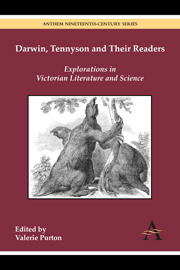Book contents
- Frontmatter
- Contents
- Introduction
- Chapter 1 Tennyson's ‘Locksley Hall’: Progress and Destitution
- Chapter 2 ‘Tennyson's Drift’: Evolution in The Princess
- Chapter 3 History, Materiality and Type in Tennyson's In Memoriam
- Chapter 4 Darwin, Tennyson and the Writing of ‘The Holy Grail’
- Chapter 5 ‘An Undue Simplification’: Tennyson's Evolutionary Afterlife
- Chapter 6 ‘Like a Megatherium Smoking a Cigar’: Darwin's Beagle Fossils in Nineteenth-Century Popular Culture
- Chapter 7 ‘No Such Thing as a Flower […] No Such Thing as a Man’: John Ruskin's Response to Darwin
- Chapter 8 Darwin and the Art of Paradox
- Chapter 9 Systems and Extravagance: Darwin, Meredith, Tennyson
- Chapter 10 T. H. Huxley, Science and Cultural Agency
- Notes on Contributors
Chapter 6 - ‘Like a Megatherium Smoking a Cigar’: Darwin's Beagle Fossils in Nineteenth-Century Popular Culture
- Frontmatter
- Contents
- Introduction
- Chapter 1 Tennyson's ‘Locksley Hall’: Progress and Destitution
- Chapter 2 ‘Tennyson's Drift’: Evolution in The Princess
- Chapter 3 History, Materiality and Type in Tennyson's In Memoriam
- Chapter 4 Darwin, Tennyson and the Writing of ‘The Holy Grail’
- Chapter 5 ‘An Undue Simplification’: Tennyson's Evolutionary Afterlife
- Chapter 6 ‘Like a Megatherium Smoking a Cigar’: Darwin's Beagle Fossils in Nineteenth-Century Popular Culture
- Chapter 7 ‘No Such Thing as a Flower […] No Such Thing as a Man’: John Ruskin's Response to Darwin
- Chapter 8 Darwin and the Art of Paradox
- Chapter 9 Systems and Extravagance: Darwin, Meredith, Tennyson
- Chapter 10 T. H. Huxley, Science and Cultural Agency
- Notes on Contributors
Summary
‘There is nothing like geology,’ Charles Darwin wrote to his sister Catherine from the Falkland Islands in April 1834. Even for someone who had spent so much of his youth enjoying the bloody thrills of traditional field sports, ‘the pleasure of the first days partridge shooting or first days hunting cannot be compared to finding a fine group of fossil bones, which tell their story of former times with an almost living tongue.’1 Beginning at Punta Alta in September 1832 and continuing at a variety of locations into early 1834, Darwin spent much of the South American leg of the global voyage of HMS Beagle eagerly collecting the fossilized remains of extinct prehistoric creatures. As he wrote in his letter to Catherine, uncovering these gigantic osseous remains was often the source of intense pleasure, and he told his other sister, Caroline, in October 1832, ‘I have been wonderfully lucky, with fossil bones. — some of the animals must have been of great dimensions: I am almost sure that many of them are quite new; this is always pleasant, but with the antediluvian animals it is doubly so.’ The ‘cargoes of apparent rubbish’ which Darwin continually brought aboard sometimes occasioned ‘smiles’ of a different sort from his more sceptical shipmates, as the captain, Robert FitzRoy, later recalled, but Darwin was largely correct in anticipating the novelty and importance of many of his finds.
- Type
- Chapter
- Information
- Darwin, Tennyson and their ReadersExplorations in Victorian Literature and Science, pp. 81 - 96Publisher: Anthem PressPrint publication year: 2013



